I love this speech! Check it out.
Join My Newsletter!
Frank Shaw Series
The Drovers Series
Gun Runner
The Dark God Series
On Writing
Categories
I love this speech! Check it out.
For those who haven’t noticed, I just finished chapter 40 of 60 on this draft of Curse of a Dark God. My original target was September 5th to finish the draft. I’m closer in my projections than I have been in the past, but I’m clearly not going to make that date. However, I’m going to see what I can do these next three weeks and hopefully pull it off by the end of September.
This is possible. Author James Maxey just finished a novel of almost 60,000 words in one week. Yes, you heard that right. ONE WEEK! Here are his tips for doing this and here was his master plan when he started. I got to read his updates a few times each day. It was simply amazing.
Of course, there’s no way I can write 60,000 words in one week. Not because I think it’s impossible. But because it takes time. James had a week off and spent like 10 hours a day at it. I can’t take a week off. But even if I could, I don’t write as fast as James. But hopefully I can structure things to get more time and finish it in three weeks. We’ll see. I’ve been working on this draft for the last four months and have put in about 240 hours on it, roughly 12.5 per week. My slow 500 words per hour that I can’t seem to budge (yes, some is writing and some is revising as I go along). I wanted to get a solid 20 hours in each week–that’s really the key–and am disappointed I haven’t managed to do this. Of course, it’s hard with a full-time job and family and a daughter going off to college and life. Waa, waa, waa. But I’m going to see what I can do to boost that to 25 hours per week for the next few weeks. The good thing is that I’m really enjoying the story on the page.
As for manuscript size, the issue with the last draft, right now the manuscript is 123,000 words. The target is around 170,000. I’m roughly on track to hit that. I’m trying to keep my chapters around 2,500 words. We’ll see how close I get.
 After reading Made to Stick, I decided to read the book that inspired it—The Tipping Point: How Little Things Can Make a Big Difference by Malcolm Gladwell. I’d read Blink and Outliers by the same author and found both fascinating. I’m happy to report The Tipping Point is just as good. In it, Gladwell examines what conditions cause ideas, behaviors, messages, and products to spread like outbreaks of infectious disease.
After reading Made to Stick, I decided to read the book that inspired it—The Tipping Point: How Little Things Can Make a Big Difference by Malcolm Gladwell. I’d read Blink and Outliers by the same author and found both fascinating. I’m happy to report The Tipping Point is just as good. In it, Gladwell examines what conditions cause ideas, behaviors, messages, and products to spread like outbreaks of infectious disease.
In the book he shares a number of situations and studies, including the sudden drop in crime in New York city in the 1990’s (which started by attacking graffiti in the subway), the dramatic popularity of the Blue’s Clues TV program with pre-schoolers, Paul Revere’s success in rousing the citizens along his route (versus the almost total failure of the other guy who rode that night), the resurgence of Hush Puppies shoes, syphilis in Baltimore, Columbia Record’s amazingly effective golden box ad campaign, and a dozen other outbreaks. From all of these, he extrapolates three rules of social epidemics—The Law of the Few, The Stickiness Factor, and The Power of Context.
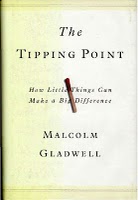 The arguments Gladwell presents are thought-provoking and powerful, but what makes him such a treat to read is how he writes. Like the best science writers (in fact, I think he IS one of the best), he tells great stories with interesting characters. He puts the reader on the edge of the seat with mystery, insight, and humor. He makes things that could be incredibly complex seem like first grade math. It’s as if he’s standing right there with you chatting about the subject. Moreover, he does all this from page one.
The arguments Gladwell presents are thought-provoking and powerful, but what makes him such a treat to read is how he writes. Like the best science writers (in fact, I think he IS one of the best), he tells great stories with interesting characters. He puts the reader on the edge of the seat with mystery, insight, and humor. He makes things that could be incredibly complex seem like first grade math. It’s as if he’s standing right there with you chatting about the subject. Moreover, he does all this from page one.
Here’s what I mean. I left the book out on the kitchen table one night after reading a few chapters. The next morning Super Wife came down to quickly eat breakfast and get herself to a meeting. She made the mistake of opening the book to glance at the first page. Twenty-five minutes later she came up for air and realized she was going to be late and dashed out the door. The writing is pure mind control. And I loved every minute of it.
If you’re at all interested in advertising or how fads and movements start, if you want to affect the behavior of customers or local teens, if you just like to read how things work, I think you’ll love this book.
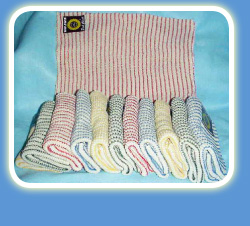 I used to suffer along with subpar dish cloths. There were the dish cloths with mesh on one side that were so small you had to rinse them after every wiping stroke. There were the hand cloths made of terri that belonged in a bathroom but were repurposed and were far too big. Then were the cloths that had some slippery crap in the thread that refused to soak up water. And there were the crocheted things that I think we should have put out of their misery when we first got them. Folks suggested we go to sponges. So we did sponges and had similar results.
I used to suffer along with subpar dish cloths. There were the dish cloths with mesh on one side that were so small you had to rinse them after every wiping stroke. There were the hand cloths made of terri that belonged in a bathroom but were repurposed and were far too big. Then were the cloths that had some slippery crap in the thread that refused to soak up water. And there were the crocheted things that I think we should have put out of their misery when we first got them. Folks suggested we go to sponges. So we did sponges and had similar results.
Oh, woe, woe, woe.
Then a kind and loving friend gave us a set of mystery cloths that were incredible. They were large enough that we didn’t need to rinse with every wipe. They had this fantastic weave that was open, yet absorbent, and dried quickly. And the weave had enough of a texture that you could use it to scrub. We received those back in 1999. They lasted us for years and gave us much kitchen cleaning joy. But, alas, like all of mortality, those brave cloths finally began to give up the ghost.
My problem was that I didn’t know who had made those cloths and where I could get more. We looked all over and couldn’t find them. And then, at this year’s Garden City Raspberry Days craft fair, we saw them nestled amidst all the kitsch! We bought as many as we could afford, and went our way rejoicing, fully expecting these to last us until we have grandchildren. Maybe we’ll pass them down as priceless heirlooms. Maybe some day they’ll be featured on Antique Roadshow. Maybe they’ll be resurrected with us and become the official dish cloth of the Millennium when the world is renewed (it could happen).
If you’re sick and tired of sponges and crappy dish cloths, let me suggest you pick up some Sunflower Dish Cloths made by Sangamon Mill. You can order them in bulk at http://www.sangamonmill.com/ , or in smaller quantities online from places like Amazon.
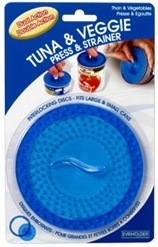 Do you eat tuna? If so, you know the biggest pain is draining the can. But you don’t have to suffer along any longer using the lid, which doesn’t do a good job at all anyway. There’s a better solution, which Super Wife discovered. It’s called the Tuna and Veggies Press and Strainer by Evriholder: http://www.evriholder.com/Tuna-Veggie-Press.asp. With this little blue piece of higher technology you easily and quickly press all the juices away, and nothing slips out the sides. We love our. You can order it online, although Super Wife found it at our local evil empire Wal-Mart store.
Do you eat tuna? If so, you know the biggest pain is draining the can. But you don’t have to suffer along any longer using the lid, which doesn’t do a good job at all anyway. There’s a better solution, which Super Wife discovered. It’s called the Tuna and Veggies Press and Strainer by Evriholder: http://www.evriholder.com/Tuna-Veggie-Press.asp. With this little blue piece of higher technology you easily and quickly press all the juices away, and nothing slips out the sides. We love our. You can order it online, although Super Wife found it at our local evil empire Wal-Mart store.
That’s it for now. In the next review, I’m going to reveal two killer recipes over which all who partake will salivate and drool—Chocolate Éclair Cake and Dill Potato Salad.
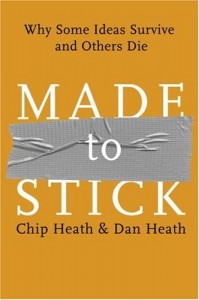 A friend of a friend of mine is a frequent business traveler. To keep his identity safe, I’ll call him Bill. Bill was recently in Atlantic City for an important meeting with some new clients. Afterward, he went to a local bar to kill some time before his flight and took a seat at a table.
A friend of a friend of mine is a frequent business traveler. To keep his identity safe, I’ll call him Bill. Bill was recently in Atlantic City for an important meeting with some new clients. Afterward, he went to a local bar to kill some time before his flight and took a seat at a table.
He’d just finished one drink when an attractive woman approached and asked if she could buy him another. He was surprised, but flattered (Bill isn’t exactly a Brad Pitt). He accepted the drink. The woman walked to the bar and brought back two more drinks—one for her and one for him. He thanked her and took a sip. And that was the last thing he remembered . . . before he woke up, disoriented, lying in a hotel bathtub, his body submerged in ice.
He looked around frantically, trying to figure out where he was and how he got there. Then he spotted the note:
DON’T MOVE. CALL 911.
A cell phone rested on a small table beside the bathtub. He picked it up and called 911, his fingers numb and clumsy from the ice. The operator seemed oddly familiar with his situation. She said, “Sir, I want you to reach behind you, slowly and carefully. Is there a tube protruding from your lower back?”
Anxious, he felt around behind him. Sure enough, there was a tube.
The operator said, “Sir, don’t panic, but one of your kidneys has been harvested. There’s a ring of organ thieves operating in this city, and they got to you. Paramedics are on their way. Don’t move until they arrive.”
Incredible, isn’t it?
More importantly, do you think you could remember enough of that, without review, to tell it to someone tomorrow?
My guess is that you could. And if you did, you’d be spreading one of the most successful urban legends of the past fifteen years.
But I didn’t tell you the story to focus on urban legends. There are a lot of stories people tell one another that don’t go viral. What makes this one different? In fact, what makes any idea stick effortlessly, like this one does, in someone’s brain?
Are you a teacher? In school, at home, or at your business? Do you give presentations? Do you ever need to advertise something—a product, service, or yourself? If so then you’ve had this question.
Maybe you’ve uncovered some of the secrets. Maybe you haven’t. But there’s no reason to despair: Chip and Dan Heath have written the book on it. It’s called Made to Stick: Why Some Ideas Survive and Others Die and is one of the most fascinating and practical reads I’ve come across in the last few years.
The brothers Heath spent hundreds of hours researching sticky ideas: urban legends, advertising campaigns, wartime rumors, proverbs, conspiracy theories, jokes, some of the nation’s best teachers—you name it; if it was sticky, they looked at it. They asked questions like what makes some urban legends so compelling? Why do some chemistry lessons work better than others? Why do some political ideas circulate widely and others fall short? What they found was that sticky ideas exhibit six traits. And it was relatively easy for someone, once they understood those traits, to make almost any idea stickier.
I can see the traits in some of the things that I’ve done that have been sticky. I can see other ways to improve. The cool thing is that I’m not going to be guessing as much. If you need to make your ideas stick, let me recommend you get this book. If you want a preview, go to madetostick.com.
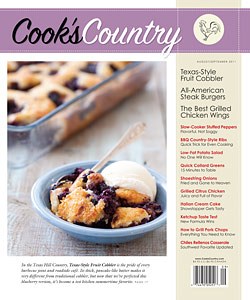 I was once induced, through insidious mind control, to purchase a cookbook that included all sorts of tempting dishes. I prepared a number of the recipes, and every one of them was a bust, especially the cinnamon flank steak with eggplant, which I think Nellie and I chewed for about six hours until our jaws dropped off.
I was once induced, through insidious mind control, to purchase a cookbook that included all sorts of tempting dishes. I prepared a number of the recipes, and every one of them was a bust, especially the cinnamon flank steak with eggplant, which I think Nellie and I chewed for about six hours until our jaws dropped off.
Not satisfied to learn my lesson once, I soon purchased another book on making bread the Old World way. Despite our best efforts and many valiant attempts, all we could produce were loaves that were so bitter and sour they could have been used at Guantanamo Bay to threaten captured Talibanists to talk.
Let’s just say that after a few more of these, I finally beat back the mind control. I’ve been gun-shy of cookbooks ever since. We’ve been very selective over the years, and this has saved me some money. Unfortunately, I think all of those lessons learned are going to go out the window.
I was recently watching the Create channel and saw an episode of Cook’s Country where they showed how to make coleslaw that wouldn’t get all watery and a grilled chicken with traditional Southern white BBQ sauce that had me slavering in my seat. During the show they talked about testing these recipes and their failures.
I learned that the folks there had just finished an eleven-season series called America’s Test Kitchen (where was I all that time?). In the series, they tested hundreds of recipes five ways to Sunday to come up with ones that really worked.
When the episode of Cook’s Country finished, the old cookbook mind control had risen to full force. This time, though, I was able to exercise some restraint. Instead of buying fifty cookbooks, I started a 14-day trial to Cook’s Country magazine, a thirty-four page, oversized, bi-monthly that’s full of recipes that have been tested.
One of the neat features is that they don’t simply present the recipes, they also include the stories behind the testing so a reader can learn from their failures and successes right along with them. In fact, the stories of the tests were so interesting I made Nellie sit down while I read them to her. The magazine also includes cooking tips and product ratings. In the issue I received, I learned, for example, which egg wash proved, through testing, the most successful on pies and which graham cracker tasted best in recipes. One of the best things about the magazine is that, unlike many magazines that have three sentences of content and forty pages of advertisements, Cook’s Country has zero advertisements. Zero! It’s nothing but cooking.
We’ve tried five recipes so far. Three of them have been clear winners for all the tasters in this family. There other two were good, but not spectacularly so. Still, there weren’t any cinnamon flank steaks!
In the next set of reviews, I’ll share their potato salad recipe that had us all oohing and aahing. And maybe the chocolate éclair cake we adjusted to perfection. I’m going to continue the subscription and give their family cookbook a try. I’ll report my results. In the meantime, I suggest you look at Cook’s Country magazine online at cookscountry.com or watch the show on Create.
How they pray at NASCAR. Boogity, boogity, boogity, amen!